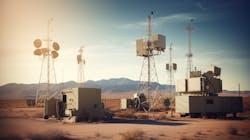Air Force approaches industry on five-year project to develop secure ultra-broadband radio communications
ROME, N.Y. – U.S. Air Force communications are asking industry to develop an ultra-broadband radio that not only operates at frequencies higher than 100 GHz, but also that dynamically adjusts carrier frequency, output power, and data rate.
Officials of the Air Force Research Laboratory Information Directorate in Rome, N.Y., issued a broad agency announcement (FA8750-23-S-7009) on Tuesday for the Ultra-Broadband Terahertz Radio Development project.
Radio frequencies above 100 GHz, commonly known as terahertz or sub-terahertz band, remain underused for communications, despite their potential to enable secure wideband applications for communications systems, Air Force researchers say.
The high atmospheric absorption at these frequencies can limit the effective transmission range but also can be used for secure channelization in contested spectrum environments.
Air Force researchers want to design, develop, and demonstrate an ultra-broadband radio that dynamically adjusts carrier frequency, output power, and data rate within the frequency range of interest—above 100 GHz.
Recent advances in material and device technology have enabled components and subsystems such as power amplifiers, low-noise amplifiers, frequency multipliers, and antenna array subsystems that operate above 100 GHz.
Over the past decade technology development has demonstrated wireless links at 140, 200, 240, 300 GHz and above, and the next technology challenge is to develop a compact end-to-end communications system that operates in sub-terahertz and terahertz bands.
Researchers want an ultra-broadband radio that dynamically adjusts carrier frequency, output power and data rate within 100 to 300 GHz using state-of-the-art modem design for fast flexible baseband that can support spreading bandwidth to 10 GHz and data rate of 1 megabit to 1 gigabit per second, as well as adapt to atmospheric conditions, link requirements, and the presence of interference. The system also should be able to form and shape the terahertz beams to control the signal’s presence in time and space.
This project should be worth about $10 million through 2028, and several contracts are expected. For now, Air Force researchers are asking only for white papers, and those submitting promising white papers will be asked to submit formal proposals. Foreign participation is not allowed.
Companies interested should email white papers no later than 15 Dec. 2023 for 2024 awards; by 20 Sept. 2024 for 2025 awards; by 19 Sept. 2025 for 2026 awards; by 18 Sept. 2026 for 2027 awards; and by 17 Sept. 2027 for 2028 awards.
Email white papers to the Air Force's Ngwe Thawdar at [email protected], with copies to Claire Parisi at [email protected] and to Peter Ricci at [email protected].
Email questions or concerns to the Air Force's Amber Buckley at [email protected].
The Air Force will brief industry on the Ultra-Broadband Terahertz Radio Development project from 9 a.m. to 5 p.m. on Tuesday 17 Oct., at the Innovare Advancement Center, 592 Hangar Road, in Rome, N.Y.
Briefings will provide an overview of the problem, promote areas of interest, promote an early exchange of information, and provide an opportunity for the Air Force and industry to gather more information prior to the submission of white papers.
A general session will be from 9 a.m. to 2 p.m. with a lunch break. Written questions will be answered after a recess for lunch, which will not be provided. Private will be scheduled from 2 to 5 p.m.
Those who are not able to attend the industry day may request a copy of questions and answers after the event by emailing [email protected] and being properly vetted. The Industry Day will be held at unclassified level, Controlled Unclassified Information (CUI) and open to defense contractors who are US Citizens.
Those interested in attending the industry briefings should register no later than 2 Oct. 2023. Email [email protected] for a registration form and more information for this event. More information is online at https://sam.gov/opp/c3c3a1dc3d28424ca468ebb081cddb04/view.
About the Author
John Keller
Editor-in-Chief
John Keller is the Editor-in-Chief, Military & Aerospace Electronics Magazine--provides extensive coverage and analysis of enabling electronics and optoelectronic technologies in military, space and commercial aviation applications. John has been a member of the Military & Aerospace Electronics staff since 1989 and chief editor since 1995.
